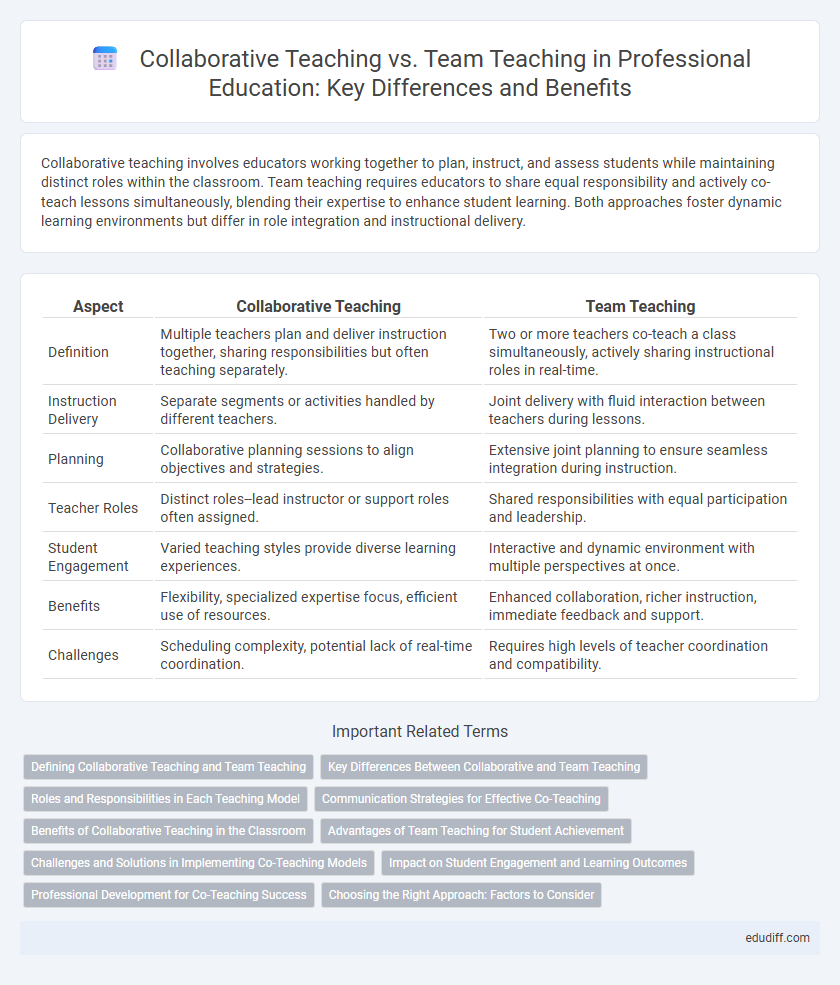Collaborative teaching involves educators working together to plan, instruct, and assess students while maintaining distinct roles within the classroom. Team teaching requires educators to share equal responsibility and actively co-teach lessons simultaneously, blending their expertise to enhance student learning. Both approaches foster dynamic learning environments but differ in role integration and instructional delivery.
Table of Comparison
| Aspect | Collaborative Teaching | Team Teaching |
|---|---|---|
| Definition | Multiple teachers plan and deliver instruction together, sharing responsibilities but often teaching separately. | Two or more teachers co-teach a class simultaneously, actively sharing instructional roles in real-time. |
| Instruction Delivery | Separate segments or activities handled by different teachers. | Joint delivery with fluid interaction between teachers during lessons. |
| Planning | Collaborative planning sessions to align objectives and strategies. | Extensive joint planning to ensure seamless integration during instruction. |
| Teacher Roles | Distinct roles--lead instructor or support roles often assigned. | Shared responsibilities with equal participation and leadership. |
| Student Engagement | Varied teaching styles provide diverse learning experiences. | Interactive and dynamic environment with multiple perspectives at once. |
| Benefits | Flexibility, specialized expertise focus, efficient use of resources. | Enhanced collaboration, richer instruction, immediate feedback and support. |
| Challenges | Scheduling complexity, potential lack of real-time coordination. | Requires high levels of teacher coordination and compatibility. |
Defining Collaborative Teaching and Team Teaching
Collaborative teaching involves multiple educators working together to plan, instruct, and assess students, often dividing responsibilities based on expertise. Team teaching, a subset of collaborative teaching, features co-teachers actively delivering instruction simultaneously within the same classroom setting. Understanding these distinctions is essential for optimizing instructional strategies and enhancing student engagement.
Key Differences Between Collaborative and Team Teaching
Collaborative teaching involves educators sharing planning and instructional responsibilities while maintaining distinct roles in the classroom, enhancing diverse expertise integration. Team teaching requires co-teachers delivering instruction simultaneously, promoting real-time interaction and co-facilitation with shared authority. Key differences include the degree of joint delivery and role integration, with collaborative teaching emphasizing shared planning and team teaching focusing on synchronized instruction.
Roles and Responsibilities in Each Teaching Model
Collaborative teaching involves teachers sharing responsibilities such as planning, instruction, and assessment while maintaining individual accountability for their specific content areas. In team teaching, educators co-deliver lessons simultaneously, actively engaging in joint decision-making and real-time instructional adjustments. Roles in collaborative teaching are often divided based on expertise, whereas team teaching requires seamless coordination and equal participation throughout the teaching process.
Communication Strategies for Effective Co-Teaching
Effective communication strategies in co-teaching include establishing clear roles, setting shared objectives, and utilizing consistent, open dialogue to ensure alignment between Collaborative Teaching and Team Teaching methods. Active listening, regular feedback sessions, and leveraging digital tools for planning enhance coordination and address challenges promptly. Prioritizing transparent communication fosters a supportive environment that maximizes student engagement and learning outcomes.
Benefits of Collaborative Teaching in the Classroom
Collaborative teaching enhances student learning by integrating diverse expertise and instructional strategies, fostering a dynamic educational environment. This approach promotes tailored support, increased engagement, and higher achievement through shared responsibilities and continuous peer feedback. Teachers benefit from professional growth and reduced workload, resulting in improved classroom management and student success.
Advantages of Team Teaching for Student Achievement
Team teaching enhances student achievement by combining diverse expertise, allowing real-time feedback and personalized instruction. Students benefit from varied teaching styles and increased engagement, which promotes deeper understanding and critical thinking. This collaborative approach fosters a dynamic learning environment, improving academic outcomes and retention rates.
Challenges and Solutions in Implementing Co-Teaching Models
Collaborative teaching faces challenges such as aligning teaching styles, managing time constraints, and balancing responsibilities between educators, while team teaching often struggles with role ambiguity and coordination complexities. Solutions include establishing clear communication protocols, defining specific roles and shared goals early in the planning process, and scheduling regular meetings to address conflicts and adjust strategies. Utilizing technology for lesson planning and feedback can enhance collaboration efficiency and support continuous improvement in co-teaching models.
Impact on Student Engagement and Learning Outcomes
Collaborative teaching fosters student engagement by integrating diverse instructional strategies from multiple educators, enhancing the learning environment through shared expertise and varied perspectives. Team teaching directly impacts learning outcomes by allowing co-teachers to dynamically adapt lessons in real-time, providing immediate feedback and differentiated support tailored to student needs. Research indicates that environments utilizing both collaborative and team teaching models show increased student motivation, deeper comprehension, and higher achievement levels compared to traditional solo instruction.
Professional Development for Co-Teaching Success
Collaborative teaching emphasizes shared planning and reflective practices to enhance professional development, fostering mutual growth and skill-building among educators. Team teaching involves simultaneous instruction by two teachers in the same classroom, requiring strong communication and adaptability to effectively co-manage learning environments. Prioritizing structured collaboration and ongoing professional learning is crucial for maximizing co-teaching success and improving student outcomes.
Choosing the Right Approach: Factors to Consider
Choosing between collaborative teaching and team teaching depends on factors such as the desired level of interaction, subject complexity, and available resources. Collaborative teaching suits environments where educators design lessons independently but share student assessments, while team teaching requires simultaneous instruction and co-delivery, ideal for dynamic classroom engagement. Evaluating teaching goals, student needs, and instructor compatibility helps determine the most effective approach.
Collaborative Teaching vs Team Teaching Infographic

 edudiff.com
edudiff.com